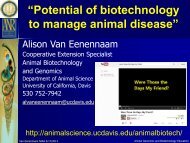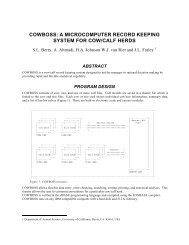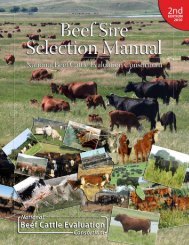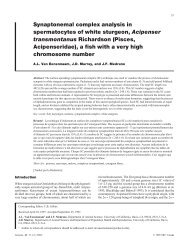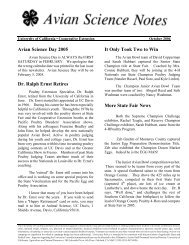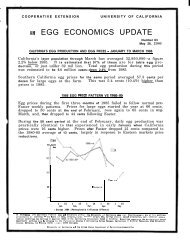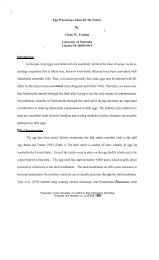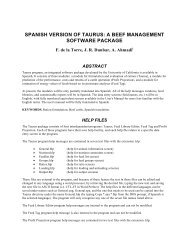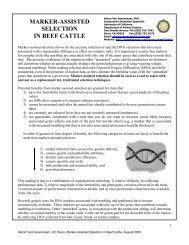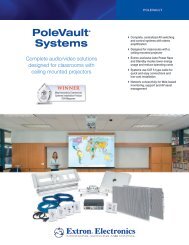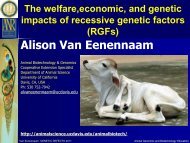Delbert Gatlin-1.pdf - Department of Animal Science
Delbert Gatlin-1.pdf - Department of Animal Science
Delbert Gatlin-1.pdf - Department of Animal Science
Create successful ePaper yourself
Turn your PDF publications into a flip-book with our unique Google optimized e-Paper software.
Update on Protein and Amino Acid Nutrition<br />
Research with Red Drum (Sciaenops<br />
( Sciaenops ocellatus) ocellatus<br />
<strong>Delbert</strong> M. <strong>Gatlin</strong>, III<br />
<strong>Department</strong> <strong>of</strong> Wildlife and Fisheries <strong>Science</strong>s<br />
and Faculty <strong>of</strong> Nutrition,<br />
Texas A&M University System,<br />
College Station, Texas
Background<br />
• Red drum is a prominent aquaculture<br />
species in the Gulf coast states.<br />
– Stock enhancement<br />
– Food fish
Fishmeal Use in Aquafeeds<br />
• Year 2000 - Approximately 2 million metric tons <strong>of</strong> fish<br />
meal were used in aquafeeds<br />
• Year 2010 - Approximately 4.3 million metric tons <strong>of</strong><br />
fish meal are projected to be used in aquafeeds if<br />
aquaculture continues to grow at current rate<br />
• A greater understanding <strong>of</strong> amino acid requirements<br />
is needed for ingredient substitution and refinement <strong>of</strong><br />
diet formulations<br />
• Underutilized resources such as seafood processing<br />
waste and by-catch need further development
Evaluation <strong>of</strong> Different Sulfur<br />
Compounds in Diets <strong>of</strong><br />
Red Drum<br />
Jonathan G<strong>of</strong>f and <strong>Delbert</strong> M. <strong>Gatlin</strong>, III
Sulfur Amino Acid Nutrition<br />
• Compared to fish meal, sulfur amino acids are<br />
limiting in some feedstuffs such as soybean meal.<br />
• Methionine supplementation may be required when<br />
replacing fish meal.<br />
• Various methionine supplements are available, but<br />
their utilization by different fish species has been<br />
varied.
Methionine hydroxy analogue (MHA) utilization by<br />
fish has been variable but its use in diets <strong>of</strong><br />
terrestrial animals may reduce ammonia excretion
Percent (%)<br />
100<br />
75<br />
50<br />
25<br />
0<br />
B<br />
Survival<br />
A A A A<br />
Basal L-met DL-met MHA Met:Lys<br />
Diet<br />
Exp. 1<br />
p-value = 0.0001
Percent <strong>of</strong> initial wt.<br />
500<br />
450<br />
400<br />
350<br />
300<br />
250<br />
200<br />
150<br />
100<br />
50<br />
0<br />
B<br />
Weight Gain<br />
A A A A<br />
Basal L-met DL-met MHA Met:Lys<br />
Diet<br />
Exp. 1<br />
p-value = 0.0001
g gain/ g feed<br />
0.9<br />
0.8<br />
0.7<br />
0.6<br />
0.5<br />
0.4<br />
0.3<br />
0.2<br />
0.1<br />
0<br />
Feed Efficiency<br />
B<br />
A A A A<br />
Basal L-met DL-met MHA Met:Lys<br />
Diet<br />
Exp. 1<br />
p-value = 0.0030
Protein Efficiency Ratio<br />
g gain/g protein fed<br />
2.5<br />
2<br />
1.5<br />
1<br />
0.5<br />
0<br />
B<br />
A A A A<br />
Basal L-met DL-met MHA Met:Lys<br />
Diet<br />
Exp. 1<br />
p-value = 0.0051
Experimental Diets<br />
• Nine diets were formulated to contain:<br />
– 35% crude protein<br />
– 11% lipid<br />
– 3.5 kcal DE/g<br />
• All diets except the basal satisfied the total sulfur<br />
amino acid requirement and were maintained<br />
isonitrogenous with aspartic acid.<br />
• Sulfur compounds were supplemented on an equalsulfur<br />
basis and included:<br />
– L-Met, DL-Met, MHA, ALIMET ® , N-acetyl-Met, and different<br />
ratios <strong>of</strong> Met:Cys
Diet formulations (% dry wt.)<br />
Ingredient (%<br />
dry weight)<br />
Red drum<br />
muscle<br />
AA premix<br />
Menhanden<br />
oil<br />
Dextrin<br />
Vitamin/Min.<br />
premix<br />
Carboxymeth<br />
yl cellulose<br />
Cellulose<br />
L-Met<br />
L-Cys<br />
Basal<br />
11.8<br />
24.0<br />
10.2<br />
26.7<br />
7.0<br />
2.0<br />
17.2<br />
0<br />
0<br />
L-Met<br />
11.8<br />
24.0<br />
10.2<br />
26.7<br />
7.0<br />
2.0<br />
17.2<br />
0.52<br />
0<br />
40% Cys<br />
11.8<br />
24.0<br />
10.2<br />
26.7<br />
7.0<br />
2.0<br />
17.2<br />
0.24<br />
0.28<br />
45% Cys<br />
11.8<br />
24.0<br />
10.2<br />
26.7<br />
7.0<br />
2.0<br />
17.2<br />
0.18<br />
10.34<br />
50% Cys<br />
11.8<br />
24.0<br />
10.2<br />
26.7<br />
7.0<br />
2.0<br />
17.2<br />
0.13<br />
0.39
Experimental Methods<br />
• Closed, recirculating system containing<br />
brackish water (7 ppt) at 27ºC<br />
• 12 fish stocked into each 110-l aquarium<br />
• Initial fish weight = 14 g<br />
• 7-week duration<br />
• Data subjected to ANOVA<br />
and Tukey’s HSD
Percent <strong>of</strong> initial wt.<br />
300<br />
250<br />
200<br />
150<br />
100<br />
50<br />
0<br />
A<br />
Basal<br />
Weight Gain<br />
BC C<br />
L-met<br />
DL-met<br />
B B<br />
N-acetyl<br />
Diet<br />
Alimet<br />
BC BC BC BC<br />
MHA<br />
40%Cys<br />
45%Cys<br />
50%Cys<br />
p-value < 0.001
g gain/g fed<br />
0.8<br />
0.7<br />
0.6<br />
0.5<br />
0.4<br />
0.3<br />
0.2<br />
0.1<br />
0<br />
Feed Efficiency<br />
A<br />
Basal<br />
B B<br />
L-met<br />
DL-met<br />
B B B B B B<br />
N-acetyl<br />
Diet<br />
Alimet<br />
MHA<br />
40%Cys<br />
45%Cys<br />
50%Cys<br />
p-value < 0.001
Protein Efficiency Ratio<br />
g gain/g protein fed<br />
2.5<br />
2<br />
1.5<br />
1<br />
0.5<br />
0<br />
A<br />
A<br />
Basal<br />
B B B B B B B B<br />
L-met<br />
DL-met<br />
N-acetyl<br />
Diet<br />
Alimet<br />
MHA<br />
40%Cys<br />
45%Cys<br />
50%Cys<br />
p-value < 0.001
Conclusions<br />
• Various sulfur compounds including MHA<br />
and ALIMET ® were used equally well by<br />
red drum<br />
• Cystine replaced up to 50% methionine<br />
on an equal-sulfur basis<br />
• Effects <strong>of</strong> MHA and ALIMET ® on<br />
ammonia excretion are being evaluated
Seafood Processing Waste and<br />
By-catch By catch Utilization Project<br />
A collaborative project between Texas A&M<br />
University and the University <strong>of</strong> Idaho<br />
• Gulf <strong>of</strong> Mexico<br />
•Alaska<br />
Alaska<br />
Shrimp processing waste<br />
Shrimp by-catch by by-catch catch<br />
Fish processing waste<br />
Fisheries by-catch by by-catch catch
Objectives<br />
• Characterize the nutritional value <strong>of</strong><br />
various processing wastes and<br />
fisheries by-catch by by-catch catch<br />
• Subject the products to low-<br />
temperature processing at Bio- Bio Bio-<br />
Oregon in Warrenton, OR
Marine By-products<br />
• Shrimp by-catch meal (SBM) – assorted<br />
fish and crustaceans from Gulf shrimper<br />
• Shrimp waste meal (SWM) – processing<br />
waste from aquacultured shrimp<br />
• Pacific whiting (PW)<br />
• Pacific whiting with solubles (PWS)<br />
• Red salmon head meal (RSHM) –<br />
processing waste from red salmon
Objectives<br />
•Evaluate Evaluate the nutritional value <strong>of</strong><br />
developed products in diets <strong>of</strong><br />
red drum and rainbow trout<br />
–levels levels <strong>of</strong> substitution in diets<br />
based on comparative feeding trials<br />
–digestibility digestibility <strong>of</strong> protein, amino<br />
acids, energy and minerals<br />
(primarily phosphorus)
Feedstuff<br />
Proximate Composition<br />
<strong>of</strong> Protein Feedstuffs<br />
% dry matter<br />
Dry matter Protein Lipid<br />
Menhaden fish meal (MFM) 90.2 69.1 13.2 19.9<br />
Shrimp by-catch meal (SBM) 98.0 66.1 7.6 23.1<br />
Pacific Whiting without soluble<br />
(PW)<br />
Pacific Whiting with soluble<br />
(PWS)<br />
91.4 79.1 13.6 5.4<br />
96.3 76.8 14.5 6.2<br />
Shrimp waste meal (SWM) 93.3 53.4 1 17.1 22.7<br />
Red salmon head meal<br />
(RSHM)<br />
Ash<br />
96.3 60.1 34.4 6.4<br />
1 This value is overestimated (approx. 5%) due to presence <strong>of</strong> chitin containing non-protein nitrogen.
Ingred.<br />
Experimental Diets<br />
*All diets formulated at 40% crude protein, 10% lipid, 3.5 kcal DE/g<br />
100%<br />
MFM<br />
(Control)<br />
50%<br />
SBM<br />
100%<br />
SBM<br />
50%<br />
PW<br />
100%<br />
PW<br />
50%<br />
PWS<br />
100%<br />
PWS<br />
25%<br />
RSHM<br />
MFM 57.9 29.0 60.5 29.0 0 29.0 0 43.4 29.0<br />
SBM 0 30.3 0 0 0 0 0 0 0<br />
PW 0 0 0 25.3 50.6 0 0 0 0<br />
PWS 0 0 0 0 0 26.0 52.1 0 0<br />
RSHM 0 0 0 0 0 0 0 16.6 0<br />
SWM 0 0 0 0 0 0 0 0 37.4<br />
50%<br />
SWM
Experimental Diets ( cont’d) cont d)<br />
100% 50% 100% 50% 100% 50% 100% 25% 50%<br />
Ingredient<br />
MFM<br />
(control)<br />
SBM SBM PW PW PWS PWS RSHM SWM<br />
Dextrin 15.06 15.06 15.06 15.06 15.06 15.06 15.06 15.06 15.06<br />
Menhaden<br />
Oil 5.16 6.68 8.21 5.53 5.90 5.20 5.24 1.35 2.59<br />
Vitamin<br />
Premix 3.00 3.00 3.00 3.00 3.00 3.00 3.00 3.00 3.00<br />
Mineral<br />
Premix 4.00 4.00 4.00 4.00 4.00 4.00 4.00 4.00 4.00<br />
CMC 2.00 2.00 2.00 2.00 2.00 2.00 2.00 2.00 2.00<br />
CaCO 3 5.52 4.31 3.10 9.93 14.34 9.68 13.84 7.35 2.81<br />
Cellulose 7.34 5.73 4.12 6.22 5.08 6.22 4.79 6.22 4.16
Feeding Trial<br />
•Initial fish weight =3.8 ± 0.3g<br />
•15 fish stocked into each 110-L aquarium<br />
•Closed, recirculating system containing<br />
brackish water (6.0 ppt) at 25 ± 2 ºC<br />
•Each diet fed to fish in three replicate<br />
aquaria at the same fixed rate<br />
•Trial duration = 6 weeks
(%)<br />
100<br />
90<br />
80<br />
70<br />
60<br />
50<br />
40<br />
30<br />
20<br />
10<br />
0<br />
Control 50%SBM 100%<br />
SBM<br />
Survival<br />
50% PW 100% PW 50% PWS 100%<br />
PWS<br />
Diet<br />
50%<br />
SWM<br />
25%<br />
RSHM<br />
P = 0.1176
% <strong>of</strong> initial wt.<br />
400<br />
350<br />
300<br />
250<br />
200<br />
150<br />
100<br />
50<br />
0<br />
a<br />
abc<br />
Control 50%<br />
SBM<br />
Weight Gain<br />
bcd<br />
100%<br />
SBM<br />
bcd<br />
50%<br />
PW<br />
de cd de<br />
100%<br />
PW<br />
50%<br />
PWS<br />
100%<br />
PWS<br />
50%<br />
SWM<br />
25%<br />
RSHM<br />
Diet P = 0.0004<br />
e<br />
ab
g gain / g fed<br />
1<br />
0.8<br />
0.6<br />
0.4<br />
0.2<br />
0<br />
a<br />
ab<br />
Control 50%<br />
SBM<br />
Feed Efficiency<br />
bc bc<br />
100%<br />
SBM<br />
50%<br />
PW<br />
de<br />
100%<br />
PW<br />
Diet<br />
bcd<br />
50%<br />
PWS<br />
bcd<br />
100%<br />
PWS<br />
e<br />
50%<br />
SWM<br />
a<br />
25%<br />
RSHM<br />
P
g gain / g protein fed<br />
2.5<br />
2<br />
1.5<br />
1<br />
0.5<br />
0<br />
Protein Efficiency Ratio<br />
a<br />
ab<br />
Control 50%<br />
SBM<br />
bc bc<br />
100%<br />
SBM<br />
50%<br />
PW<br />
de<br />
100%<br />
PW<br />
Diet<br />
bcd<br />
50%<br />
PWS<br />
bcd<br />
100%<br />
PWS<br />
e<br />
50%<br />
SWM<br />
a<br />
25%<br />
RSHM<br />
P
Conclusions<br />
• By-catch from shrimp trawls and red salmon<br />
meal are nutritious feedstuffs for red drum<br />
• More limited substitution <strong>of</strong> menhaden fish<br />
meal (< 50%) with other by-products will be<br />
required to reduce impaired fish performance<br />
• Utilization <strong>of</strong> shrimp-processing waste may<br />
be limited by excessive chitin<br />
• Digestibility determinations with the various<br />
products are currently underway
Acknowledgments<br />
• Granvil Treece <strong>of</strong> Texas Sea Grant –<br />
Co-Principal Investigator<br />
• Zena Wang and Peng Li – graduate<br />
assistants<br />
• Gary Graham <strong>of</strong> Texas Sea Grant for<br />
assistance in acquiring by-catch from<br />
commercial shrimpers<br />
• Robert Sanchez <strong>of</strong> Tex-Mex Packers for<br />
acquiring shrimp-processing waste<br />
• Bio-Oregon Inc. for processing the<br />
various products



